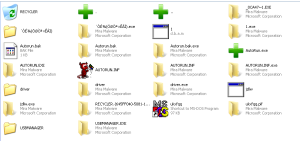Infection of removable drives is an old trick and no point explaining what it is. What is interesting though is looking at creativity of guys who leverage this infection vector and not the ones that exploit the autorun.inf mechanism (yawns!), but the one that focuses on social engineering.
Assuming that a potential victim of ‘removable device infection’ is typically not a very computer savvy individual is actually quite easy. We all know that it’s the guys like these that are a typical pray for malware authors.
But are they the only ones?
There is so many things one can do to place clickbaitfiles on the removable drive that the victim will end up clicking. It is stronger than us. Whether a rookie or a pro. You have seen it, I have seen it – the guys clicking, clicking… until it works. I have done it too.
Infection via a removable device is still a perfect social engineering platform and I’d say it is not going away anytime soon.
Looking at some of the sandboxes samples I have analyzed I created a short list of tricks I have spotted so far (send me more if you know others, and care to share).
- hide the folder, create an .exe with the same name and ensure the .exe is using a folder icon
- use ‘current’ and ‘directory up’ file names i.e. ‘..exe’ and ‘…exe’
- use important-looking file names, also in foreign languages
匆删(重要资料).exe
- leverage desktop.ini to change the appearance of the folder (f.ex. bin folder)
[.ShellClassInfo]
CLSID={645FF040-5081-101B-9F08-00AA002F954E}
- use various file extensions: .exe, .scr, .pif, .lnk
- double .exe (.exe.exe), triple .exe (.exe.exe.exe)
- intriguing names (sex&pr0n in general, controversy&scandal)
- use attractive looking icons – yup, it’s thats imple
- Fake Recycler folders
- obviously, a randomized autorun.inf is a norm now
[AutoRun] ;FLvfB ysQiGKArLcs sheLl\open\commAnD = ukxfqq.pif
;fWJoARTstov kivfsp SHeLL\oPEn\dEfault=1 ;tCcl bcaolB WdIa BdqhbkeGrp Shell\explorE\COmmand= ukxfqq.pif ;ngFiihrOUk open =AutoRun.exe ;KyGpw shEll\AutOpLAY\COMMaND=ukxfqq.pif shell\1=Open shell\1\Command=AutoRun.exe shell\2\=Browser shell\2\Command=AutoRun.exe shellexecute=AutoRun.exe ;YtGyagvMMf ceqdP ymhOtYeaQn
Look at the screenshot below.
Be honest.
What you would NOT click?
mind you – it is good ol’ Windows XP!
and same – on Windows 7
Update
What does the topic of this post have in common with sandboxing?
It would be cool for sandboxes to highlight these artifacts (if they don’t, yet)…
If any sample drops its copy on a removable drive or another well-known file associated with social engineering i.e. exhibits one of the behaviors described above (and more, subject to more analysis) the ‘maliciousness’ score can easily go up.
Everyone wins. I hope 🙂

